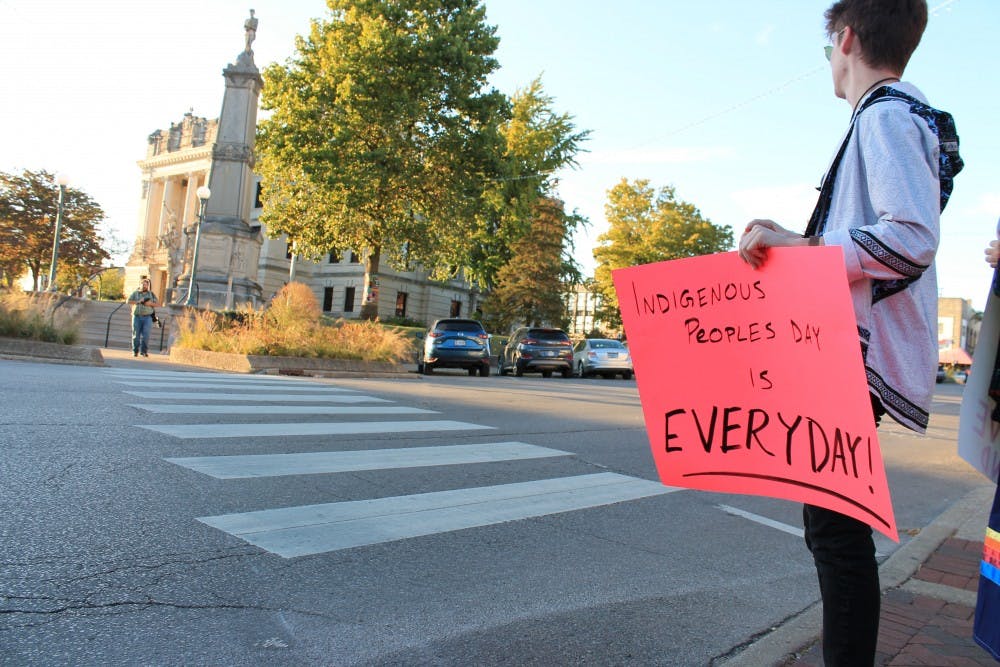About 25 people marched from Dunn Meadow to the Monroe County Courthouse on Monday evening to celebrate Indigenous Peoples’ Day.
The march and gathering at the courthouse were some of the IU First Nations Educational and Cultural Center’s events for Indigenous Peoples’ Day. Two weeks ago, the Bloomington city council voted unanimously to recognize the holiday in Bloomington every second Monday of October, which is recognized as Columbus Day in other parts of the United States.
Around 40 people gathered at the courthouse, where indigenous members of the Bloomington community, Shawnee tribe Chief Ben Barnes and city council member Isabel Piedmont-Smith spoke. There was also an Aztec dance performance later in the evening.
Lauren Kirby, 22, said it’s important to reclaim Columbus Day.
“I’d much rather celebrate indigenous people than the C-word,” she said.
Autumn Brunelle is a 26-year-old Bloomington resident and a member of the Anishinaabe tribe from northern Minnesota. She wore a ribbon skirt, which she said was popular during the fur trading era and is now a political symbol often associated with the Missing and Murdered Indigenous Women movement. She said Indigenous Peoples’ Day is a celebration of survival.
“We can celebrate surviving hundreds of years of genocide and continued colonialism of our people,” Brunelle said.
Piedmont-Smith, who was the resolution’s main sponsor, read the new legislation declaring the holiday at the courthouse.
“This imperialist ethos allowed for the inhumane treatment of the Native peoples, their eradication from their homelands and the cession of these lands to the federal government,” Piedmont-Smith read.
Some members of the crowd held posters with messages such as “In 1492, Native Americans Discovered Columbus Lost At Sea,” “Strong. Resilient. Indigenous.” and “We will not celebrate genocide.” One poster depicted a location marker and “Native Land” written in red underneath it.
City council member Dorothy Granger, one of the sponsors of the resolution, held up a pink sign that read: “We are on Native land. This is all Native land.”
Nicky Belle, director of the First Nations Educational and Cultural Center, said some of the tribes that have inhabited Indiana are the Shawnee, Delaware, Potawatomi and Miami. The resolution also includes the Pawnee, Kickapoo, Wea, Wyandot and Piankashaw tribes. Some of these tribes still live in Indiana.
“We must always stay connected with these communities,” Belle said.
The Native community in Bloomington is small, and Native people aren’t fully recognized, Brunelle said. It can feel lonely.
“Look to your left, look to your right,” Brunelle said to the crowd at the courthouse. “These people love you, and we all support you. If you ever need anything, look to your left, look to your right. We’re here for you.”
Takoda Potts, an IU junior studying biotechnology, is a member of the Sioux tribe and is involved with the First Nations Educational and Cultural Center on campus. He said IU has a small indigenous population. He is the only Sioux tribe member he knows of, which he said can feel isolating.
He said having Native friends helps him feel less lonely, and Indigenous Peoples’ Day is a way for the Native community at IU and in Bloomington to join together.
“It’s nice to have a day to celebrate, embrace our struggles and identities and come together as a community,” he said.
Many times Native people are viewed as being frozen in a precolonial era or not even existing anymore, Brunelle said.
“It’s a nice feeling to actually be seen,” she said.
Bloomington’s resolution recognizing Indigenous Peoples’ Day states the city’s commitment to work toward equality for Native people.
“The City of Bloomington has a responsibility to oppose systemic racism toward indigenous people of the United States, which perpetuates high rates of poverty and income inequality, exacerbating these communities’ disproportionately negative health, education and social welfare indicators,” the resolution reads.
Caleb King, president and founder of the IU Native American Student Association, said he was happy to celebrate Indigenous Peoples’ Day. He said he thinks it’s a good first step toward equality for indigenous people in America.
“Today is a celebration,” King said. “It’s also a reminder that work is never done.”




